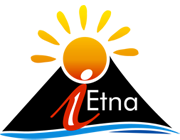In June and July an important seismic experiment in Sicily (Italy), focused at Etna volcano and its surrounding areas named TOMO-ETNA, will take place. The seismic experiment is part of the activities of the European project “MEDiterranean SUpersite Volcanoes (MED-SUV)”, which is coordinated by Istituto Nazionale di Geofisica e Vulcanologia. TOMO-ETNA, integrates MED-SUV efforts with the resources of another EC research project (EUROFLEETS 2), and of others funding agencies from Italy (INGV), Spain (CSIC), and Germany (GFZ). Furthermore, TOMO-ETNA is also supported by the active participation of the Marina Militare Italiana.
The focus of this experiment concerns the investigation of Etna volcano roots by means of passive and active refraction (WAS) and reflection (MCS) seismic methods. The experiment will be performed both on-land and offshore by a new high-resolution tomography (seismic tomography experiment - TOMO-ETNA) that will improve the 3D image of crustal structures beneath the volcano and the surrounding areas. The final goal is to gain a structural model of the crust in northern Sicily, including a better mapping of tectonic structures (faults), and to define the physical processes controlling magma ascent beneath Mt. Etna.
In the experiment simultaneous artificial seismic signals generated by air-guns from a oceanographic research vessel (Sarmiento de Gamboa, Spain) and natural seismicity of the region will be used. Additionally, the Galatea vessel from the Istituto Idrografico della Marina Militare will be used to carry out further geophysical surveys (such as gravity and magnetic measurements) and to support activities at sea.
The scheduled activities are divided into two actions, land and sea, and will last from June 25th to July 20th. Seismic signals will be generated at sea and recorded by about 170 seismic stations deployed on-land and 25 OBS (ocean bottom seismometer) at the seafloor. It is expected the participation of more than 60 researchers from different countries, mainly from Italy and Spain but also from Germany, Russia, US, Ireland and Mexico.
The TOMO-ETNA experiment will be coordinated from Prof Jesus Ibanez of the University of Granada (Spain) and by Prof Domenico Patanè and Dr Mauro Coltelli from the INGV, Sezione di Catania - Osservatorio Etneo.
The expected results will impact not only the local and European volcanological communities but also the population leaving on the volcano in terms of volcano risk mitigation. Indeed, the current vulnerability of society to volcanic eruptions is increased significantly in recent decades, as demonstrated by the consequences of the recent eruptions of Mount Etna in spite of their small magnitude. In this perspective, therefore, the better the volcanic processes are known the more we can be prepared to mitigate the impact on the territory.







